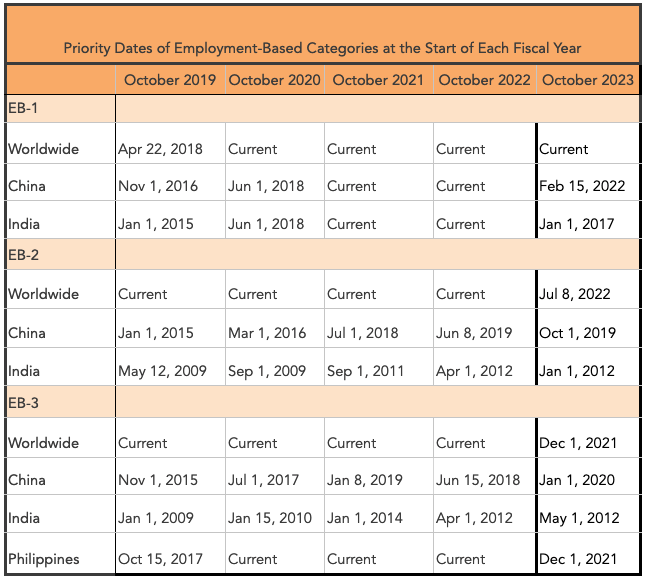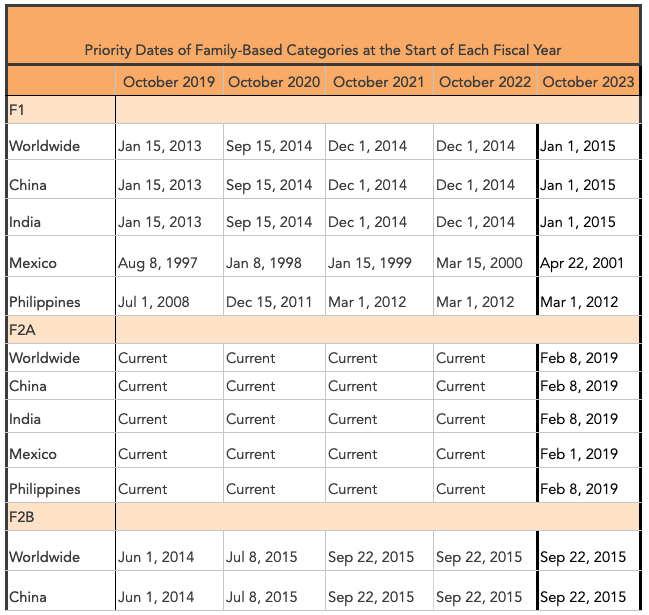A Five-Year Review of the Immigrant Visa Bulletin
Under U.S. immigration law, only a certain number of green cards can be issued each year for family members and employment. Because the demand for green cards far exceeds the number of green cards that can be granted each year, the number of applications pile up, resulting in substantial backlogs and long wait times. For some family members, the wait time for a green card can be as long as 25 years.
Each month, the U.S. Department of State releases a Visa Bulletin which lists the “priority dates” for each employment and family based category for the upcoming month. A priority date is a person’s place in line for a green card based on when their immigrant petition was filed (Form I-130 for family-based cases and Form I-140 for employment-based cases). In the case of certain employment-based cases, the place in line is based on when the application for alien labor certification (Form ETA-9089) has been filed.
Below are two charts I prepared to show you how much progress has happened over the last five years for the employment and family based categories. For employment-based categories, I have focused on the first three of the five categories. I use the dates from the October Visa Bulletin for the last five years because October is when the fiscal year starts for the US government and the annual allocation of green cards is replenished. The October Visa Bulletin is very important because it usually sets the tone for the year ahead.
Employment-Based Movement
For employment-based green cards (also referred to as “immigrant visas”), the number of immigrant visas available each fiscal year is 140,000. The first three employment-based categories ("EB-1", "EB-2" and "EB-3") get about 40,040 immigrant visas each per year with a 7% cap for nationals of any one country per category. This means a maximum of 2,803 visas are available to nationals of a single country per category. This also explains the backlog for Chinese and Indian nationals for all three employment-based categories because the majority of applicants for employment-based green cards are from India and China. Accompanying dependents of foreign nationals applying for employment-based green cards also count towards the annual allocation
By way of background, the first preference employment-based category (“EB-1”) is for individuals of extraordinary ability, outstanding researchers and scientists, and international executives and managers. The second preference category (“EB-2”) is for professions that require an advanced degree or individuals working in the national interest. The third preference category (“EB-3”) is for professionals and skilled workers.
When you look at the chart below, you will see that dates can move forward and backward (“retrogression”) from year to year. These patterns are important to understand when planning for permanent residence.
Family-Based Movement
For family-based green cards (“immigrant visas”), the number of immigrant visas available each fiscal year is 226,000 (yes, more than employment). The 7% cap for nationals of any one country per category applies for family-based categories as well. This explains the backlog for Chinese, Filipinos, Indian, and Mexicans because the majority of applicants for family-based green cards are from these countries.
By way of background, the first preference family-based category (“F-1”) is for unmarried adult sons and daughters of U.S. citizens for which the annual allocation is 23,400. The second preference category is divided into two sub-categories. F-2A is for spouses and children of permanent residents for which the annual allocation is roughly 87,934. F-2B is for the unmarried children over the age of 21 of permanent residents. The annual allocation for F-2B is 26,266. The F-3 category is for married children of U.S. citizens. The annual allocation for F-3 is 23,400. Finally, the F-4 category is for siblings of U.S. citizens for which the annual allocation is 65,000.
There is no annual limit for spouses, parents and children under 21 of U.S. citizens, so the Visa Bulletin does not apply to them. Spouses, parents and children under the age of 21 of US citizens qualify as immediate relatives and apply for their green card without waiting for their place in line to become current.
As you can see, the family-based categories move forward quite slowly. On average, the priority dates have moved forward by about two years over the last five years. This trend is important to know when planning for the immigration of family members.
Country of Birth Determines Nationality for Green Card Processing
Under U.S. immigration law, the country in which a person is born generally determines the country of nationality for green card processing. For example, if you are a Canadian citizen and you were born in India, you are an Indian national for green card processing. By contrast, if you were born in Singapore, but are a citizen of India, you are treated as a national of Singapore for green card processing.
If you are married to a foreign national, your spouse’s country of birth can also be considered for green card processing. For example, if you are a Chinese national being sponsored for an employment-based green card and you are married to a foreign national born in Mongolia, you can use your spouse’s Mongolian country of birth to move through the green card process faster.
Planning the Journey
As these charts show, the priority dates for the various employment and family-based green cards usually move forward slower than calendar years. So my first recommendation is to get in line as soon as you can. If you are a US citizen with a foreign national brother or sister, file the petition for alien relative (Form I-130) for them so they have a place in line. If they ultimately decide they aren’t interested in moving to the United States, that’s fine, but at least the option is available to them. My second recommendation is to keep an eye on priority dates, especially for family-based categories where getting married or your parent naturalizing could change your eligibility and place in line. For employment-based cases, exploring options for upgrading or even downgrading your employment-based category is wise because you take your priority date with you when a new I-140 is filed on your behalf (or if you file it, in the case of extraordinary ability petitions and national interest waivers). Relatedly and finally, my third recommendation is to keep these dates in perspective. They fluctuate and can have significant forward and backward movement. Your priority date will become current one day and you will have up to one year to act on it.
I hope you found these charts helpful. If you would like to discuss your options further, please don’t hesitate to contact me. I’d be delighted to help.
This alert is for informational purposes only. Please contact us if you would like to discuss these developments further.



